

Building an Artificial Brain.
Robot Platform. ROS. Robotics news. The ROSCon 2017 organizing committee aims for ROSCon to represent the entire ROS community, which is diverse and global.
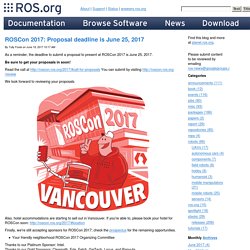
In addition to promoting technology that is open source, we also strive to ensure that our communities themselves are as open and accessible as possible, since we recognize that diversity benefits the ROS ecosystem as a whole. Whoever you are, whatever you do, and wherever you do it, if you're interested in ROS, then we want you to join us at ROSCon. To help reduce the financial barriers to conference attendance, the ROSCon organizing committee is offering a number of scholarships to members of traditionally underrepresented groups in the tech community. Thanks to the support of the program's sponsors, these scholarships each include a complimentary conference registration pass and three nights' accommodation shared with another recipient*.
Limited travel support is available for participants whose travel to the conference would otherwise be infeasible. Eligibility. Robotic Software. It is no scoop that Smartphones are attractive for robotics. They gather in a small case a display, wireless for communication, computing capabilities, and a bunch of sensors. That’s cool! In this tutorial, we will be talking about ROS namespaces which allow to combine nodes in ways unplanned by developers. This is actually what all ROS is about: allow building ROS Groovy was released on December the 31st, 2012.
Documentation - ROS Wiki. Questions. YARP - Yet Another Robot Platform. Artificial consciousness. Possible preconditions for Conscious Machines · mrquincle/conscious-machines Wiki. "Conscious Machines", by Marvin Minsky. Marvin Minsky Published in "Machinery of Consciousness", Proceedings, National Research Council of Canada, 75th Anniversary Symposium on Science in Society, June 1991.
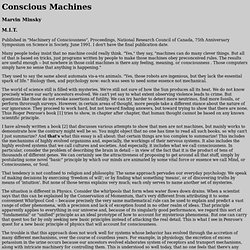
I don't have the final publication date. Many people today insist that no machine could really think. "Yes," they say, "machines can do many clever things. But all of that is based on tricks, just programs written by people to make those machines obey preconceived rules. They used to say the same about automata vis-a-vis animals. The world of science still is filled with mysteries. I have already written a book [2] that discusses various attempts to show that men are not machines, but mainly works to demonstrate how the contrary might well be so. SlotineLohmiller2001NNets14p.137. Neural correlates of consciousness. The Neuronal Correlates of Consciousness (NCC) constitute the smallest set of neural events and structures sufficient for a given conscious percept or explicit memory.
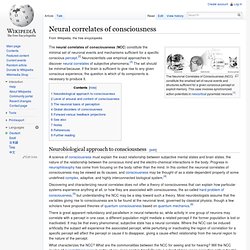
This case involves synchronized action potentials in neocortical pyramidal neurons.[1] Neurobiological approach to consciousness[edit] A science of consciousness must explain the exact relationship between subjective mental states and brain states, the nature of the relationship between the conscious mind and the electro-chemical interactions in the body. Progress in neurophilosophy has come from focusing on the body rather than the mind. Robert Rosen (theoretical biologist) Robert Rosen (June 27, 1934 – December 28, 1998) was an American theoretical biologist and Professor of Biophysics at Dalhousie University.[1] Rosen was born on June 27, 1934 in Brownsville (a section of Brooklyn), in New York City.
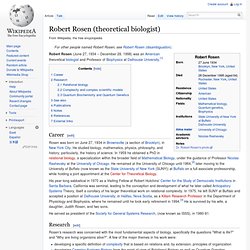
He studied biology, mathematics, physics, philosophy, and history; particularly, the history of science. In 1959 he obtained a PhD in relational biology, a specialization within the broader field of Mathematical Biology, under the guidance of Professor Nicolas Rashevsky at the University of Chicago. He remained at the University of Chicago until 1964,[2] later moving to the University of Buffalo (now known as the State University of New York (SUNY)) at Buffalo on a full associate professorship, while holding a joint appointment at the Center for Theoretical Biology. He served as president of the Society for General Systems Research, (now known as ISSS), in 1980-81.
Ratslam - Bio-inspired software for simultaneous localisation and mapping. RatSLAM: Using Models of Rodent Hippocampus for Robot Navigation. OpenRatSLAM: an open source brain-based SLAM system. RatSLAM is a navigation system based on the neural processes underlying navigation in the rodent brain, capable of operating with low resolution monocular image data.
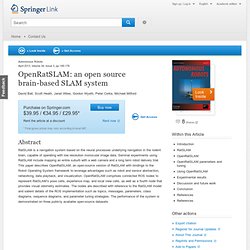
Seminal experiments using RatSLAM include mapping an entire suburb with a web camera and a long term robot delivery trial. This paper describes OpenRatSLAM, an open-source version of RatSLAM with bindings to the Robot Operating System framework to leverage advantages such as robot and sensor abstraction, networking, data playback, and visualization. Cognitive architecture. Distinctions[edit] Some well-known cognitive architectures[edit] See also[edit]

LIDA (cognitive architecture) The LIDA (Learning Intelligent Distribution Agent) cognitive architecture is an integrated artificial cognitive system that attempts to model a broad spectrum of cognition in biological systems, from low-level perception/action to high-level reasoning.
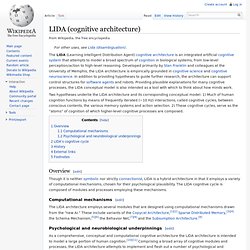
Developed primarily by Stan Franklin and colleagues at the University of Memphis, the LIDA architecture is empirically grounded in cognitive science and cognitive neuroscience. In addition to providing hypotheses to guide further research, the architecture can support control structures for software agents and robots. Copycat (software) Copycat is a model of analogy making and human cognition based on the concept of the parallel terraced scan, developed in 1988 by Douglas Hofstadter, Melanie Mitchell, and others at the Center for Research on Concepts and Cognition, Indiana University Bloomington.

The original Copycat was written in Common Lisp and is bitrotten (as it relies on now-outdated graphics libraries); however, a Java port exists. Copycat produces answers to such problems as "abc is to abd as ijk is to what? " Hierarchical temporal memory. Hierarchical temporal memory (HTM) is an online machine learning model developed by Jeff Hawkins and Dileep George of Numenta, Inc. that models some of the structural and algorithmic properties of the neocortex.
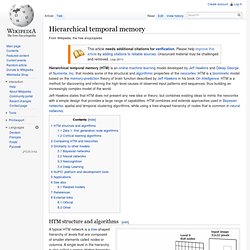
HTM is a biomimetic model based on the memory-prediction theory of brain function described by Jeff Hawkins in his book On Intelligence. HTM is a method for discovering and inferring the high-level causes of observed input patterns and sequences, thus building an increasingly complex model of the world. Jeff Hawkins states that HTM does not present any new idea or theory, but combines existing ideas to mimic the neocortex with a simple design that provides a large range of capabilities.